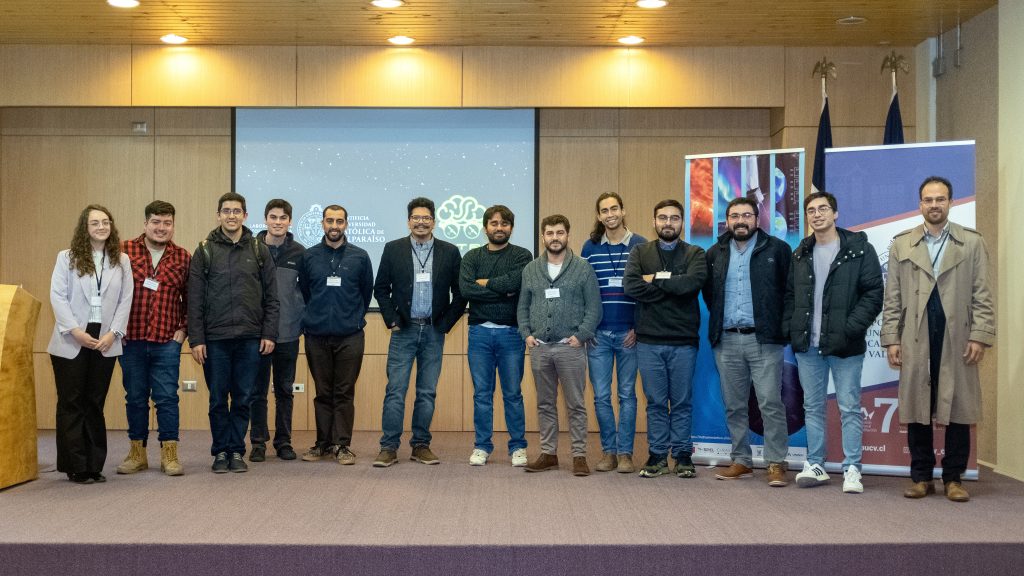The launch event of the project gathered nearly 70 attendees, among them scientist, academics and students of several national universities.
Last June the 2nd, our Optoelectronics Laboratory of the School of Electrical Engineering PUCV, directed by Dr. Esteban Vera, was in charge to do the launch of the Proyecto Anillo SEETRUE followed by a seminar that gathered academics, experts and students who were able to present their investigations and advances in themes related to adaptive optics, space surveillance and satellite communications.

SEETRUE, that means «Sharp wavefront sEnsing for adaptivE opTics in gRound-based satellite commUnications and spacE surveillance» a project that is directed by Professor Esteban Vera from the School of Electrical Engineering and is co-directed by the academic Darío Pérez from the PUCV Institute of Physics. In addition, it has the participation of Pablo Meza from Universidad de la Frontera and Marcos Díaz from Universidad de Chile, as principal investigators.
This collaborative and interdisciplinary initiative was awarded the financing of $750 USD, which is being granted by the Agencia Nacional de Investigación y Desarrollo (ANID), and will last 3 years from 2023.
¿What is the project about?
SEETRUE seeks to use Artificial Intelligence (AI) to achieve adaptive optics solutions that will be compact and low-cost for applications in space surveillance and satellite communications.
“We will use AI technologies to design optical systems, reducing the costs of optical hardware in exchange for computational hardware. These adaptive optics systems will be compact and cost-effective, allowing this technology to become widespread, achieving high-resolution images of the satellites as well as communicating with them at high speed”, as we explained in our Instagram post.
Launch of the project

Near 70 people attended the launching of the project, that counted with the presence of the Vice Chancellor for Research, Creation and Innovation of the PUCV, Ximena Besoaín; the Dean of the Faculty of Engineering, Gianni Olguín, as well as academics and students from different universities.

Vice Chancellor Besoaín expressed that “for the University this is a very important project because it brings together various disciplines with the aim of concretizing an idea that is quite innovative. I have no doubt that this project will attract outstanding students, both undergraduate and postgraduate, and from now on, I wish them the best of luck and success in what they have set out to do”, she pointed out.
Later, Dr. Sergio Torres from Universidad de Concepción presented generally the diverse applications of optical instrumentation. About the event and its attendees he said “in Chile all of this was a little lost, we were all traveling abroad and we hadn’t bothered to meet here in our own country, so I find what the lab is doing very positive”.
Seminar on optical instrumentation
Once the launch was finished, the seminar began with guests that are referents of optoelectronics and astronomy, such as professors Rodrigo Reeves from Universidad de Concepción; Martin Adams from Universidad de Chile and Jaime Anguita from Universidad de Los Andes.
On the occasion, undergraduate, master’s, doctoral and post-doctoral students, who are part of the laboratories of the universities that participate in the SEETRUE project, also presented, announcing what they’re currently working on.
It was a great experience, which provided the opportunity to share knowledge, establish new networks, and strengthen the existing ones between different houses of studies, scientists, and students who were part of the successful seminar.
“We thought the seminar was going to be something more intimate, but a many more people began to join. It was very entertaining, everyone was able to present and I think they liked what we are trying to do with this project. To the people who would like to join the Optoelectronics Laboratory we invite you to come close to us, we have many projects and ideas to do”, concluded our director, Esteban Vera.

